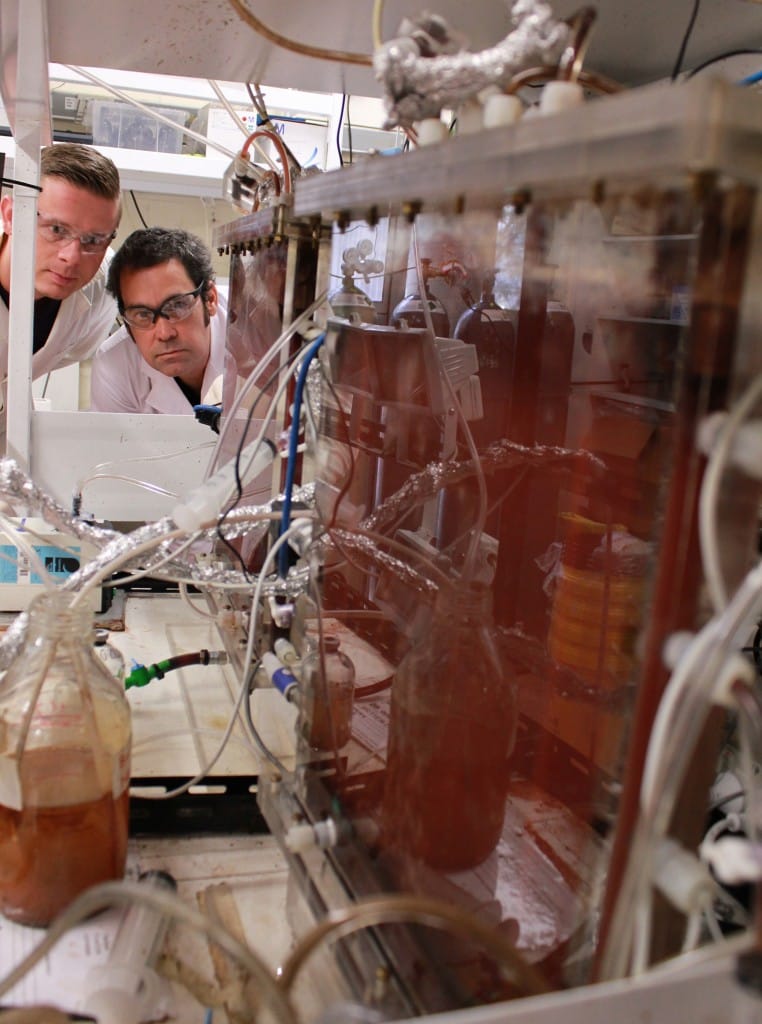Waste not, want not
 Sometimes our interests in improving the world we live in and in improving our own lives go happily hand-in-hand. Professor Damien Batstone thinks his current research project will change the world for the better. The success of the research, however, is partly due to a far more down-to-earth motivation: a doctoral student’s desire to complete a PhD as quickly as possible.
Sometimes our interests in improving the world we live in and in improving our own lives go happily hand-in-hand. Professor Damien Batstone thinks his current research project will change the world for the better. The success of the research, however, is partly due to a far more down-to-earth motivation: a doctoral student’s desire to complete a PhD as quickly as possible.
Damien’s team at the University of Queensland’s Advanced Water Management Centre (AWMC) grow microbes that remove nutrients from wastewater (treated sewage), converting those nutrients into solid form. In 2012 Tim Hülsen, a doctoral student at the AWMC, decided that to finish his PhD project early he would work with the fastest-growing environmental microbe he could find. This microbe, grown under infrared light, is now used successfully to remove elements such as nitrogen, phosphorus, and potassium from wastewater.
Plentiful or precious?
Why remove these elements? All three have value as fertilisers and are in short supply. “We can only dig so much phosphorus and potassium out of the ground,” says Damien. Meanwhile, nitrogen is taken from the air; but this process has a negative impact on the global ecosystem. The limit to our supply of fertilisers is worrisome because, as the Earth’s population grows, the need for productive agriculture grows with it. “To feed the number of people we will have to feed in the future,” says Damien, “we need to change the way we are doing things.”
Using wastewater to help meet our fertilising needs is one change that may help solve this problem. Damien is driven by the fact that “this is something which can change the world. I think I am really lucky. I didn’t go into this field thinking this was going to happen.”
The CRC for Water Sensitive Cities (CRCWSC) has been instrumental in the success of the project so far. Working with the CRCWSC, as part of Resource Recovery from Wastewater (Project C2.1), has given Damien’s team direct access to industry partners. This engagement has allowed the team to determine current needs, resulting in research that is directly useful to industry. “This puts us pretty much at the forefront of researchers working on new technologies for resource recovery from wastewater,” says Damien. It also serves to give potential stakeholders confidence that the research can be successfully implemented.

From theory to real-world use
This research comes after a long period of stagnancy in wastewater treatment. The present technology has been used successfully for around a century; but these processes do not harvest useful elements from wastewater, and are very resource-intensive. Damien says that the need for a new way of doing things is evident; and it is exciting to “work out what that new way might be. This is a way of doing things completely differently.”
Unsurprisingly, when asked what he wants to be doing in five years’ time Damien says he hopes to be translating this new technology into commercial practice. “Once it’s out there and it’s in use, the advantages will be compelling. Hopefully in five years we will be telling people that this is what they should implement as their next treatment plan.”
This is unlikely to be a hard sell. Not only does this new treatment process allow for extraction of nutrients and require fewer resources than previous technologies, it is also visually striking. There are also virtually no odours or greenhouse gas emissions. Wastewater is usually brown and smelly. Damien jokes that theirs may be the first “photogenic” wastewater treatment plant in history. Because of unusual pigmentation in the microbes, “we’ve got something that looks like red cordial.”
Bright futures
It’s clear that Damien can’t wait to sell this photogenic product to the industry at large, where it has potential to make a real difference. Like his student Tim Hülsen, Damien has been fortunate to stumble into such a fruitful area of research. Tim ended up getting something better than he had initially hoped for; instead of completing his PhD in two years as planned, he became so involved that he extended his PhD plans, completing the project right on the three-year mark with an amazing discovery under his belt. Damien neatly sums up the thrill of conducting potentially world-changing research: “I couldn’t imagine anything much more exciting than this.”
Christina Majoinen for the Mind Your Way team